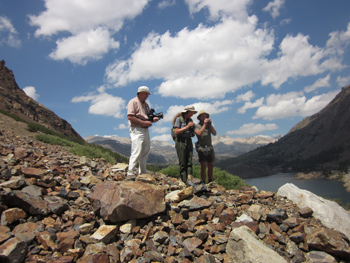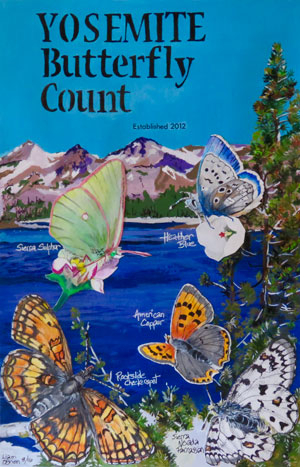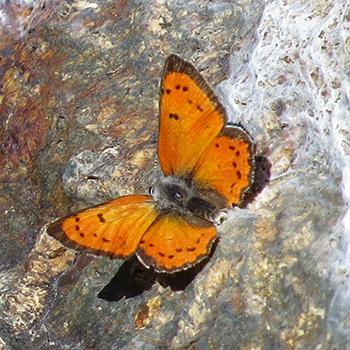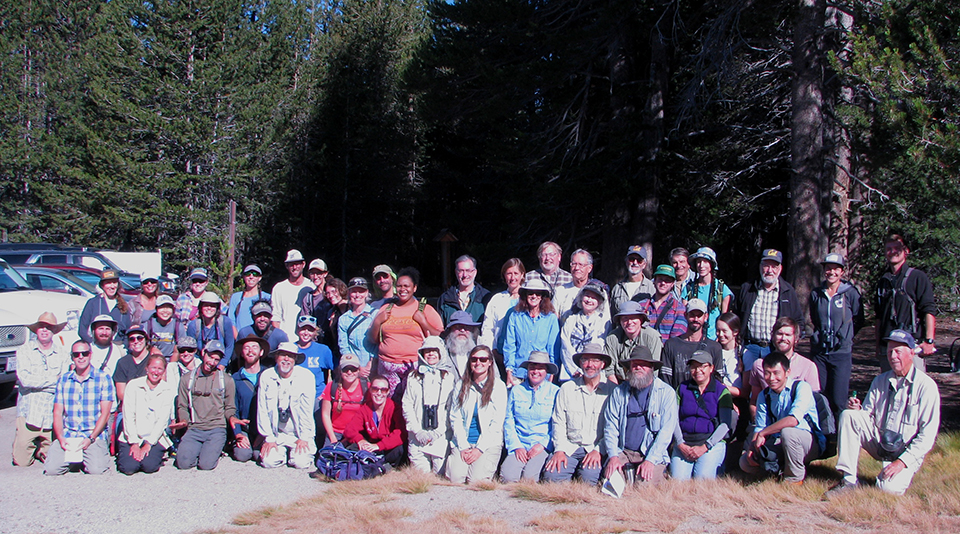
(Left) Jeffrey Glassberg, Karen Amstutz, and Ryan Carlton searching for butterflies.
On July 31, 2017, butterfly experts and enthusiasts met in the morning glow of Lembert Dome in Tuolumne Meadows in anticipation of finding as many butterflies in a single day as possible. Expert lepidopterists came from around the state to lead their groups in butterfly quests and to share their knowledge and intense appreciation for butterflies and natural history.

Following introductions, instructions, and dissemination of count datasheets, the larger group divided up into seven smaller groups, each led by one or two butterfly experts. Each group was responsible for counting and identifying butterflies in their respective zone. The butterfly count area included such hotspots as Dana Meadows, Gaylor Lakes, Saddlebag Lake, Ellery Bowl, Warren Canyon, Lower Lee Vining Canyon, Mono Lake County Park, and Lundy Lake.
A clear sky and calm winds created optimal butterfly viewing. Butterfly counters systematically searched for species that specialize on specific plants, varying degrees of moisture, and that exhibit different behaviors. Each participant learned to conjure a particular search image for target butterfly species, depending on the habitat, elevation, and the presences of certain flowering plants. The leaders enthusiastically taught the participants all facets of butterfly identification and ecology, including tips for identifying tricky species.
At the end of the day, the group reconvened back in Tuolumne Meadows to share highlights, report count results, and enjoy pizza. The highlight of every compilation is the lively discussions concerning difficult species identifications.
This year’s (2017) final tally broke previous records for the number of participants, butterfly species, and individual butterflies. Fifty-three participants counted 76 butterfly species composed of 2,191 individuals. The four most frequently detected butterflies were Orange Sulphur (149 individuals), Zerene Fritillary (126 individuals), and Woodland Skipper (106 individuals). Orange Sulphur was the only butterfly species observed by all seven groups. Missed butterflies included Lilac-bordered Copper, Pacific Fritillary, and Weidemeyer's Admiral. Ten new species observed during the Yosemite Butterfly Count included Pale Swallowtail, Pine White, Stella Orange-tip, Sooty Hairstreak, California Hairstreak, Marine Blue, Mormon Metalmark, Satyr Comma, West Coast Lady, and Common
 Wood-Nymph.
Wood-Nymph.(Left) Lustrous Copper (Lycaena cupreus) Nora Livingston
Since its inception in 2011, the Yosemite Butterfly Count has documented a remarkable diversity of 95 butterfly species. This diversity is a result of experienced and knowledgeable leaders, a growing number of participants, and diverse habitats comprising a 5,000 ft. elevation gradient between the lowest and highest zones. One group searched for butterflies along the shores of Mono Lake at 6,400 feet elevation, while another group hiked up to the Dana Plateau at 11,400 feet elevation.
This was the year of the Hairstreak! The groups collectively recorded a record high of five species: Sooty Hairstreak (40), California Hairstreak (2), Sylvan Hairstreak (11), Hedgerow Hairstreak (17), and Sheridan’s Hairstreak (10). Also notable this year was the high count (14) for the Sierra Nevada Parnassian. The Yosemite count is one of the few that regularly reports this species because in California the species is found only in alpine habitats. A relatively high count for Woodland Skipper (106) and a low count for Sandhill Skippers (8) were surprising because in past years this pattern was reversed. The lowest zone, which included the shores of Mono Lake, yielded several butterflies not observed by other groups, including Becker’s White (2), Cabbage White (5), Western Pygmy-Blue (87), Spring Azure (1), Nokomis fritillary (2), Satyr Comma (2), Red Admiral (1), Common Ringlet (1), Common Wood-Nymph (10), Common Checkered Skipper (5), and Sonoran Skipper (1). The other zones with the highest butterfly diversity were also on the east side of the crest and included areas such as Saddlebag Lake and the Warren Bench.
The combination of the butterflies themselves, people brimming over with natural history knowledge and passion, and beautiful scenery makes this one day very special. As Liam O’Brien put it, “the Yosemite Butterfly Count quickly has become Center Court/Wimbledom of the California Butterfly Count Season”. See you at next year’s count on Monday, July 30, 2018!
Additional Information
- View raw data results from 2011-2016 [60 kb PDF]
- Check out an entry (includes photos) from our High Country Notebook Blog related to the 2012 event.
- Interested in other annual events to help you connect with your inner naturalist? Each year, tens of thousands of volunteers across the Americas join together annually during the Christmas Bird Count. The event provides a full day to celebrate birds.

2017 Butterfly Count participants
Source: NPS









